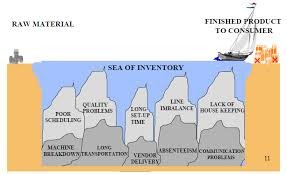Lean Quote: Closing the Knowing–Doing Gap
- Lean Quote
- October 17, 2025

On Fridays I will post a Lean related Quote. Throughout our lifetimes many people touch our lives and leave us with words of wisdom. These can both be a source of new learning and also a point to pause and reflect upon lessons we have learned. Within Lean active learning is an important aspect on
READ MORE
I believe teamwork is the real engine that will drive our initiatives through to success. Together, we will push forward and deal with the many critical issues and directives facing our industries and businesses. We all have roles in our organizations but it is the power of teamwork that makes our endeavors successful. It takes
READ MORE
One of the most misunderstood aspects of Lean is the use of inventory. Inventory is one of the eight deadly sins (wastes) in Lean manufacturing. This waste is often one that hides other wastes in our businesses. I think most are familiar with the river and boulder analogy. The water level in the river is
READ MORE
On Fridays I will post a Lean related Quote. Throughout our lifetimes many people touch our lives and leave us with words of wisdom. These can both be a source of new learning and also a point to pause and reflect upon lessons we have learned. Within Lean active learning is an important aspect on
READ MORE
For my Facebook fans you already know about this great feature. But for those of you that are not connected to A Lean Journey on Facebook or Twitter I post daily a feature I call Lean Tips. It is meant to be advice, things I learned from experience, and some knowledge tidbits about Lean to
READ MORE
Change doesn’t just happen. It needs to be driven with purpose and intent. Change management requires planning for acceptance. If you want employees to accept change, invest some time in planning and communication. Too often, managers throw a change out there and expect others to say, “Well, that’s just fine.” That’s not likely. To start,
READ MORE


